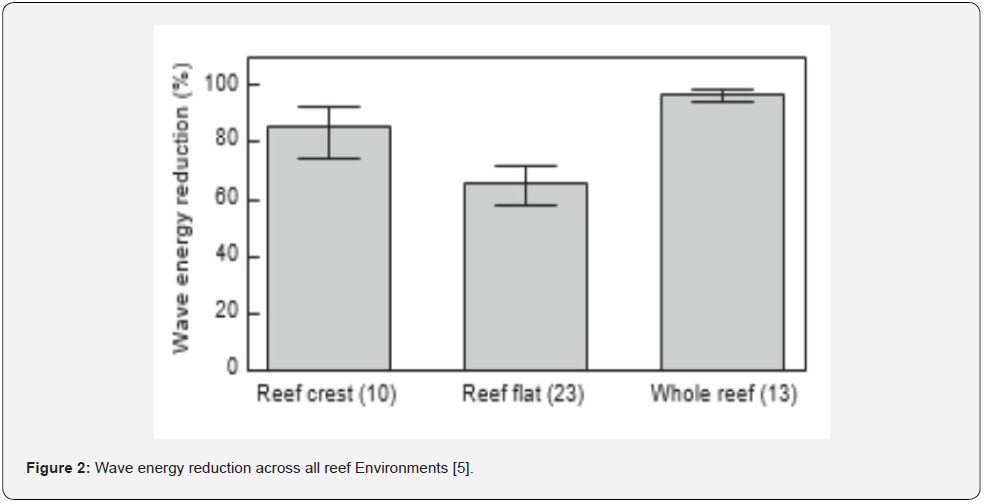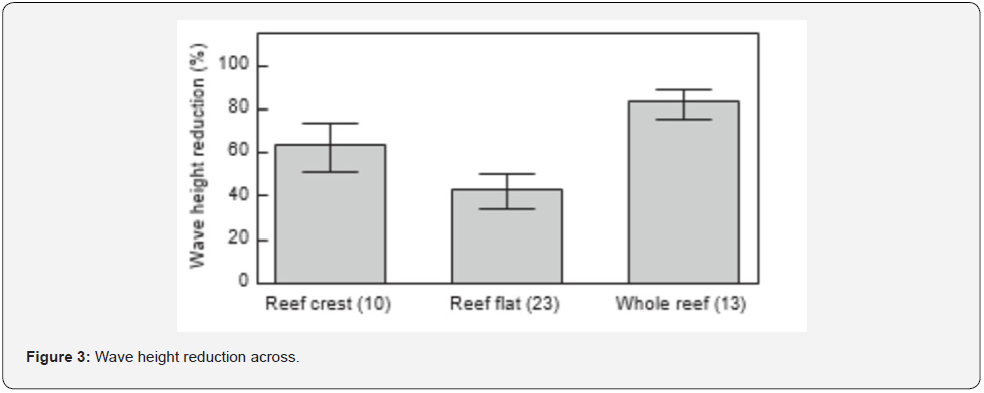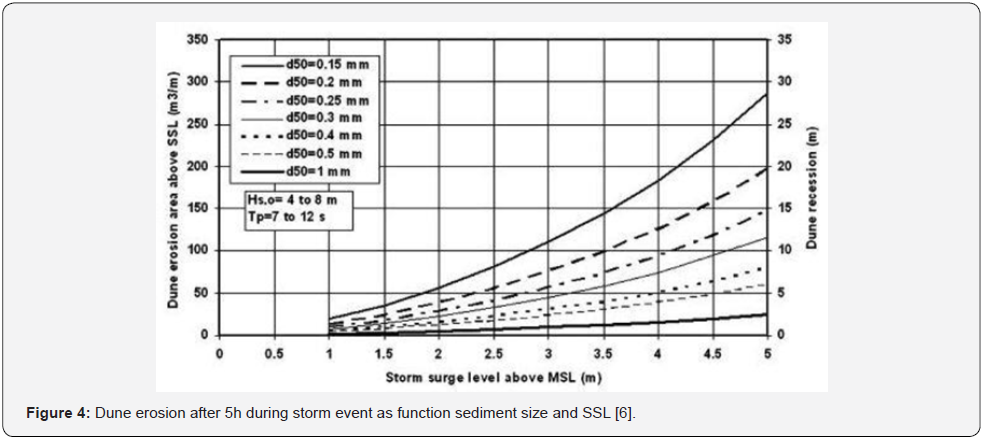Coastal Erosion Control a Review of Structural and Ecological Control Measures
Sahil Gaind*
Department of Civil Engineering, University of Ottawa, Canada
Submission: February 14, 2022; Published: March 11, 2022
*Corresponding Author: Sahil Gaind, Department of Civil Engineering, University of Ottawa, 75 Laurier avenue East, Ottawa, ON, K1N6N5, Canada
How to cite this article:Sahil G. Coastal Erosion Control a Review of Structural and Ecological Control Measures.Civil Eng Res J. 2022; 13(1): 555851. DOI 10.19080/CERJ.2022.13.555851
Abstract
Coastal erosion has become a hazard and expedited by changing climates. Earlier approaches consisted of hard structures such as breakwaters, dykes to control erosion and recent development of ecological approach using soft structures has changed the scenario. Four research articles on submerged breakwater, Tall wheatgrass, artificial coral reef and combination of these forming hybrid structures, as coastal erosion mitigation structures are selected and reviewed here in this paper. Effectiveness of erosion control technique, aesthetics erection cost, their limitations and comparison of these different techniques are concluded in the end of this review study.
Keywords: Submerged breakwaters; Artificial coral reef; Coastal protection and stabilization; Soft and hard remedial structures
Abbreviations: CDT: Critical decomposition time, ICP: Iterative closest point, SSL: Storm surge level, 3D: Three dimensional
Introduction
In recent times coastal erosion has become a major issue due to frequent storms, seawater level rise resulted from global warming. Beaches are formed by accumulations of sediment due to waves hitting the shoreline. Waves require a base to reside on, commonly the bedrock geology, waves shape them, sediment forms them, and are affected by tides. The beach runs from the wave base where waves begin to touch the bottom and shoal, across the near-shore zone, through the surf zone to the upper limit of wave swash. Waves on hitting the shore are transformed by shoaling, breaking, and swash. This forms interaction with the seabed and determines the beach morphology. Sea level rise has changed the wave direction; swell-like waves becoming more frequent which has increased coastal erosion. The change in ocean wave characteristics has expatiated shoreline deformation [1-2]. This deformation due to erosion is a threat to beaches and billions of dollars of economic activity running on coastal lines. To prevent such hazards hard and soft structures are built. Hard structures include gryones, seawalls, dikes which provide effective resistance against tidal waves, but these structures affect the ecology of the coastal biome. Another method that has taken place in recent times is soft structures such as artificial reefs, plants, mangroves and these give eco-friendly solutions. In this review paper, the traditional approach of hard structure along with ecological approaches are discussed and compared. Four journals are selected three supporting ideas of soft structures as an erosion control device and one paper about the hard structure and its disadvantages.
Discussions
Primary paper
Improved Coastal Erosion Prevention Using a Hybrid Method with an Artificial Coral Reef: Large-Scale 3D Hydraulic Experiment [3].
Background context: Coastal erosion is a continuous process, increased manifold times now. Beaches plays important role in environmental conservation and disaster prevention. Wave energy dissipation near beaches occurs by wave breaking inducement, permeability, bottom friction which reduces the overtopping, flooding run-up. Rigid structures are previously being built to attenuate wave energy. However, these structures cause rapid fluctuations, excessive suspended sediments, and disturb ecology. These structures have limitations arising from erosion at inlets, scouring, and rip currents generated by downdrift. The hybrid method is a combination of rigid and flexible methods such as sand collectors, beach drainage methods, eco-friendly artificial vegetation, and beach nourishment. Studies preventing coastal erosion using these methods have become a hot topic now. Hur et al [4] experimented with drainage channels to reduce water level rise behind the structure. Kanazawa et al [5] experimented with a permeable layer method to lower groundwater levels. Tamrin used perforated concrete blocks showing similar function to artificial reefs, to research wave attenuation. These studies have gained ground due to negative public reactions to a rigid structure. To solve this, the author experimented with submerged breakwater with artificial coral reefs, thus forming and analyzing the hybrid system. Artificial coral reef attenuates wave height with energy dissipation by drag force on the bottom surface. Wave height is high in the open inlet and low behind the structure and their flow from the inlet to the area behind the structure is generated by radiation stress gradient.
Objective: The objective of this study was to focus on the limitations of erosion at open inlets due to rip currents in submerged breakwaters. Using a large 3D hydraulic model with movable bed study was used to study sediment transport and morphological changes. Finally, analyzing the result shows the amount of wave attenuation and erosion control using the hybrid method.
Methodology: The experiment was conducted in Balai Pantai research center, Indonesia. Hydraulic model of scale 1/25 using floude’s with 3D wave flume of size 12*1*30 meters was built. A piston-type wave generator is used to create waves. Twenty-centimetre layers of different sand-size particles were created at 1:20 slope. The submerged breakwater was installed by staking sand-filled geotextile. Two experiments were done one with submerged breakwater (case 1) and the other hybridcase2 (submerged +artificial coral reef). Quick and accurate measurement was done with a 3D laser scanner (GLS1500) for morphological changes. Open-source cloud compare was used for calibrations. Data matching was done by using the iterative closest point (ICP) algorithm of cloud compare. Analysis was conducted after matching shapes to each data point, to unify the coordinate system. After data calibrations noise points and outof- range points were prepared using ICP. For validation of data, volume change was rasterized with a volume of the area having no changes. Machine error was found to be 2mm using mean deviation. Lastly, contour and path profile were analyzed.
Result & conclusion: In case 1 strong flow field of value -18.5 cm/sec formed behind breakwater whereas in case 2 it was only -3.77 m/sec. Stress gradient was found to be lower in case 2 than in case 1. The hybrid method reduces long-shore currents causing stabilization of the beach. Tracking of flow qualitatively was done using dye. On plotting flow distribution, it showed that in case 1 flow moves toward the right, i.e., flow in the offshore direction in open inlet exited through inlet after 5 sec. This is an indication of strong flow through submerged breakwater to open the inlet. This type of current causes local scours and erosion near the control structure. However, in the hybrid method flow exiting open inlet was relatively lower than the case 1. The hybrid method shows promising results in solving the problem of local scour and erosion around the open inlet of the submerged breakwater. This could also improve the efficiency of breakwaters. Therefore, this study also shows artificial reefs can be used for controlling erosion with other structures also. Experiments confirmed improvement of wave control of structures and coastline advancement.
Paper 1
Tall Wheatgrass -Its Capacity for Erosion and Flooding Control of Coastal Areas Stoyan Vergiev [6]. Nature-based erosioncontrolled strategies include the usage of plant species for coastal stabilization and protection. Integrated coastal zone management suggests ecological based mitigation strategies, which includes replacement of artificial coastal protection and stabilization structures with dunes protected by plants. Plants reduce wind velocity and with their extensive root system traps sands that absorbs wave energy. Psammophytes (scientific name of tall wheatgrass) stabilize sands and act as supporters increasing dune ability to reduce storm damages and erosion.
Objective: Stoyan Vergiev [6] aims of the present study was to record the effect of flooding stress on several wheatgrass plant life aspects (survival, viability, growth) and to find the ability of wheatgrass capacity as a coastal stabilizer.
Methodology: Two flooding simulations were created in botanical laboratory and greenhouse of the Department of plant production of Technical University of Varna. The rhizomes and whole plants of T. ponticum were collected from a former protected area Kamchiyski Pyasatsi, north-eastern Bulgaria, in April 2018 and January 2018, respectively. 32 years old plant were shifted from natural habitat and then planted in washed and sterilized mixed quartz and carbonate-silicate sand, after a month of acclimatization, the plants with pots were completely submerged in hundred liters glass tanks full of sea water and temperature of 23 Celsius is maintained constantly. The first experiment was to see visible morphological changes of different parts of plants in flooding conditions. The second experiment was to study sand holding capacity with a post immersion growth experiment that counted how immersion affects plant allocation to above and below groundmass.
Result- The result shows that the critical decomposition time (CDT) of tall wheatgrass was 168 hours and was unrelated to different water temperatures. This proves the plant’s robustness in global warming and option for erosion control. Statistical analysis of data demonstrates root to stem ratio plays important role in erosion control. So, resilience and growth of tall wheatgrass in tough conditions shows it to be of high potential as a dune stabilizer.
Paper 2
The effectiveness of Coral Reefs for Coastal Hazard Risk Reduction and Adaptation. Filippo Ferrario, Michael W Beck [7]. Huge capital is needed for constructing coastal hazard mitigation and artificial defense structures. Construction costs will increase manifold times in near times. Recent developments are in field of nature-based solutions. Proper assessment for showing effectiveness of coral reefs could encourage more research and investments into usage of coral reefs. With this objective the authors of this paper studied the effectiveness of artificial coral reefs against erosion. The research was carried to examine three coral reef environments-reef crests, flat, and the whole reef (Figure 1). The reef flat is characterized by tidal emersion,accumulation of sediments, and reduced water circulation. Reef flat extends outward from the shore and reef crest is a seaward edge. Wave breaking first occurs at reef crest. Wave energy is a function of height give as

WhereE is the wave energy density, p is the density of water,g is gravitational acceleration andH is the wave height.

Wave energy and wave height are two variables studied here. Sensors measuring energy and height of waves were placed along the shoreline (control) and on the treated area (with artificial reefs) that is the reef crest. The results from the research are shown below. Results (Figure 2) show reef crests dissipated 86% of incident wave energy while reef flats dissipated 65% of the remaining energy. Overall total wave energy reduction was found to be 97%. Data results of height (Figure 3) show significant wave reduction with 64% in the crest, 43%in flats, and overall, by 84%. This shows that both reef crests and reef flats dissipated disproportionally which concludes that more artificial reef treatment should be given to reef crests and results indicate that artificial coral reefs are effective for coastal erosion risk reduction.


Paper 3
Coastal erosion and control L.C. van Rijn. The objective of this
paper is to understand the mechanism of erosion caused by tidal
waves, the effectiveness of soft and hard remedial structures. The
major focus is on hard structures such as gryones and dikes. L.C.
van Rijn introduced that coastal erosion has two components
which are cross-shore and longshore. During extreme events,
the dunes and cliff are acted as cross-shore in which immobile
dune sediment came into the littoral system. In some cases,
they act as longshore due to the presence of tidal currents. Van
Rijn (2009) plotted a graph based on the experimental results
(below) shows the eroded area after every 5 hours as a function
of sediment size and storm surge level (SSL) (Figure 4). The
shoreline recession of dune erosion can be calculated as per the
formula here,E = Shoreline recession,A = dune erosion area
above SSL, h = dune height. Graph shows that dune recession
increases exponentially with an increase of storm surge level
here,E = Shoreline recession,A = dune erosion area
above SSL, h = dune height. Graph shows that dune recession
increases exponentially with an increase of storm surge level
The paper further discussed and tested erosion control by soft nourishment and hard structures. Hard structures reduce the recreational purpose of beaches and hence it can only use at abandoned beaches and dunes. Seawalls and revetment are in use in urban areas to counteract the erosion. Groynes structure during high wave climate shows a very high shoreline recession value which is unacceptable. Thus, these structures are making the condition worse by introducing longshore variability and local down drift erosion which results in failure of groynes structure. In some cases where sand is very scarce, hardened structure are required such as T shape groynes and detached seawalls which minimize the recreational purposes of beaches. Hard structures such as gryones, detached breakwater were numerically modelled with DEFT3D. The hard structure shows a significant reduction in coastal erosion. The author concluded that hard structures are beneficial to counteract erosion, but numerical and physical modelling is complicated, not 100 % accurate, and costly.

Critical Review/Comparison
The main research paper is supported by three different types of research which support the ideas of coastal erosion prevention. Research provides that coastal ecology is often neglected in erosion control, but plants & reefs give better solution in the prevention of erosion. In primary paper Taeyoon Kim et al. [3] shows how artificial reefs can work with hard structures thus improving the overall efficiency. While Stoyan Vergiev [6] says to focus only on ecological solutions and finding resilient plant species to prevent erosion. Filippo Ferrario, Michael W Beck [7] also supported the idea of an artificial reef by showing the result that 87% erosion reduction can be achieved. L.C. van Rijn researched hard structures and concluded that they require high capital investment, maintenance and affect the ecology.
Recommendations
In the primary paper [3] author says further research needs to be carried out to evaluate the optimized hybrid design in various locations and actual situations. Paper 1 Tall Wheatgrass -Stoyan Vergiev [6] says the further focus should be done on the root to stem ratio as it is an important parameter in the working of the whole system. Further scope is to investigate the depth of root parameters under different situations that can be used in designing erosion control systems. Paper 2 Filippo Ferrario, Michael W Beck [7] says restoring the coral reefs and their defense needs to be addressed in detail and requires collaborations from coastal engineers, geologists and ecologists [8,9]. Also, there are few studies on effect of wave reef degradation due to wave impacts on coastlines. Further research needs to account for benefit-cost analysis, fisheries, and recreation.
Overall Conclusion
After in-depth analysis, it can be concluded that coastal erosion has multiplied manifolds with global warming and has become a major coastal hazard. The coastline runs billions of dollars economy hence needs to be protected ecologically. Substantial erosion occurs along the shoulders and in-between spaces of the breakwater which can be reduced with artificial coral reefs combined with breakwaters hence, forming a hybrid system with high efficiency in erosion prevention. Tall wheatgrass also shows high flood resilience and growth response to seawater.
It shows high potential as a coastline stabilizer. Michael W Beck [7] showed reef crests attenuated 86% of incident energy while flat’s dissipates 65%. Reef crest and reef flats dissipates energy disproportionally. More artificial reef treatment should be given to reef crests. Further L.C. van Rijn research shows that dune recession increases exponentially with storm surge level. Modelling and construction of hard structures are costly affair and worsens the aesthetic look. Overall, inclusion of an ecological system in the coastal area proves to be an efficient method in the prevention of coastal erosion.
Acknowledgement
I would like to thank Professor. Scott Baker, Department of Civil Engineering, University of Ottawa for their guidance and review.
References
- Hur DS, Lee WD, Cho WC (2012) Three-dimensional flow characteristics around permeable submerged breakwaters with open inlet. Ocean Engineering 44: 100-116.
- Mimura N, Kawaguchi E (1997) Responses of coastal topography to sea-level rise. In Coastal Engineering pp. 1349-1360.
- Kim T, Baek S, Kwon Y, Lee J, Cha SM, Kwon S (2020) Improved Coastal Erosion Prevention Using a Hybrid Method with an Artificial Coral Reef: Large-Scale 3D Hydraulic Experiment. Water 12(10): 2801.
- Hur DS, Lee WD, Cho WC, Jeong YH, Jeong YM (2019) Rip current reduction at the open inlet between double submerged breakwaters by installing a drainage channel. Ocean Engineering 193: 106580.
- Kanazawa H, Matsukawa F, Katoh K, Hasegawa I (1997) Experimental study on the effect of gravity drainage system on beach stabilization. In Coastal Engineering pp. 2640-2653.
- Vergiev S (2019) Tall Wheatgrass (Thinopyrum ponticum): Flood Resilience, Growth Response to Sea Water Immersion, and Its Capacity for Erosion and Flooding Control of Coastal Areas. Environments 6(9): 103.
- Ferrario F, Beck MW, Storlazzi CD, Micheli F, Shepard CC, et al. (2014) The effectiveness of coral reefs for coastal hazard risk reduction and adaptation. Nat Commun p:1-9.
- Giardino A, Mulder J, Ronde JD, Stronkhorst J (2011) Sustainable development of the Dutch coast: Present and future. Journal of Coastal Research 61(10061): 166-172.
- Pallu S, Parung H, Thaha A (2014) Experimental Study of Perforated Concrete Block Breakwater.






























